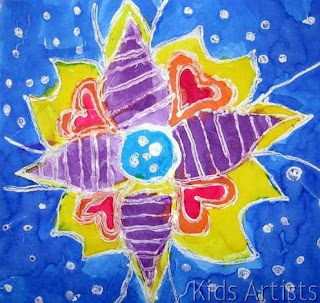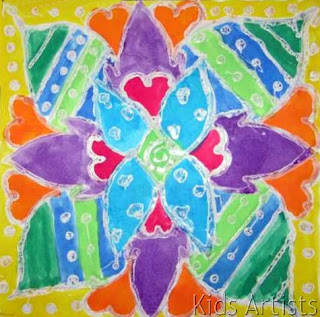- white drawing sheet A4 size
- liquid water colour
- brush
- jar with water
- indian ink
- straw
- black and yellow construction paper
- scissors
- glue
Paste the artwork on a black sheet.
A site with school-tested lessons for the Arts.
Fold the sheet of paper into quarters. Cut a heart out of a piece in the hearts: Trace this heart four times with a pencil. Draw patterns in the hearts with crayons: stripes, circles, zigzag lines etc. Draw different patterns around the hearts.
Paint the whole sheet with liquid watercolour. The crayon will resist the ink.
Made by a student of 11 years old
You need:
Students draw a web with a yellow crayon. The easiest way is to first draw diagonal lines from the corners of the paper. Then draw more lines from top to bottom, left to right. The lines must all go through the center. After this draw circles around the center, until the sheet is full.
Paint the sheet using liquid watercolour ink in cold colours. Take two colours. Leave the work to dry.
Draw some leaves with a warm colour crayon on a white sheet. Draw the veins. Paint the leaves with warm colours liquid watercolour. Let the leaves dry.
Make a spider of black construction paper. In the example above, the spider is made of a circle with a diameter of about 4 cm. Cut the circle in to the center and stick the cutting edges on each other so the center rises. Draw a cross on the back if you want to. Cut a smaller circle for the head, draw eyes on it and paste it on the body of the spider. Cut the feet: 8 strips of 8 cm by 1/2 cm. Glue the legs on the underside of the body. Make a fold inwards on the mid of the strip, and 1 cm from the end a fold outwards.
When the work is completely dry, cut the leaves and paste them on the web. Put the spider in the web by pasting the lower parts of the legs and the head.
Paste the artwork on a black background. You may draw the spider web lines on the background too.
Made by a student of 7 years old
You need:Draw a 5 cm grid and copy it on drawing sheets. Give every student a grid sheet. Students use crayons to write big handwriting letters in the squares. Trace the lines of the squares with crayon too using one colour. Paint the squares with liquid watercolour.
In Holland we call those letters 'lusletters', 'letters with loops' if I translate is. The first letters children learn, at the same time as they start learning to read, are called 'blokletters'. Block letters?
How do you call those letters? Blockletters? Writing letters? Who can help me?



You need:
This work can also be done as a group work. All trees (or groups of trees) have to be glued then on a large background of music paper.
Download the pattern of this light holder and copy it on scetch paper. Make the paper wet and leave with a big brush liquid water colour on the sheet. Those drops will flow in the water. Fill the whole sheet with colour. Leave work to dry. Do some salad oil on a plate and take a big brush. Paint the whole sheet with salad oil. Let it dry for one day. The oily sheet can best put between paper towels. Cut out the pattern. Fold the seams and adhesive borders and glue the light holder with strong glue.
You need:
Discuss with the children characteristics from owls and look at some photographs. Owls have large forward-facing eyes and ear-holes, a hawk-like beak, a flat face, and usually a conspicuous circle of feathers - a facial disc - around each eye. Although owls have binocluar vision, their large eyes are fixed in their sockets, as with other birds, and they must turn their entire head to change views.
Owls are far-sighted, and are unable to see anything clearly within a few inches of their eyes. Their far vision, particularly in low light, is exceptionally good. Owls cannot turn their heads completely backwards. They can turn their head 135 degrees in either direction; they can thus look behind their own shoulders, with a total 270 degree field of view.
Some owls have have ear-tufts on the sides of the head. Those ear-tufts are made of feathers and indicate the status: a grown-up, strong healthy owl with a large territory has large ear-tufts. Young, weak, sick or old owls have smaller ear-tufts. Most owls have a mixture of brown, black, white, and gray feathers. These colours provide camouflage, and so the owls can easily hide.
Children sketch an owl on a branch with pencil, considering the characteristics from owls we talked about before. After this, patterns have to be made in the body parts of the owl, with different sizes of black markers. By making different patterns, those body parts must be recognized. Only the eyes and the beak may be coloured yellow or orange, the rest is black or white.
When finished, the background has to be painted with yellow liquid watercolour. Don't touch the black marker lines if you didn't use a waterproof one, because the black ink will run out then. Stay away about a half centimeter from your drawing. Finally paste the artwork on black construction paper.
You need:
See the moon shining through the trees... and in the moonlight everything looks blue.
Children scetch a winter tree, so there will be no leaves. Show them that the branches at the end always be thinner. Scetch a moon between the branches. Draw a cat or an owl on one of those branches.
The tree has to be coloured with blue oil pastel. Color difference can be made by pressing harder or softer, or by using a little black or white through that blue for the feathers. Colour the owl or cat blue too. Use black to draw eyes, ears and beak. The moon is white-yellow and becomes darker yellow to the outside.When colouring is ready, everything has to be outlined with white oil pastel; even the smallest branches have to be outlined. This is a difficult chore, because you barely see the white and you run the risk that the white crayon will get blue (scrape it then!).
The background will be painted with ink, water and a scouring pad (watch your clothes!). The white lines will resist the ink. Put undiluted blue ink on a dish and dip the soft side of the scouring pad in it. Stamp with the pad along the outer edges of the drawing. Add water to the ink when you're nearer at the moon. The blue will be lighter then. Make a great light blue circle around the moon.